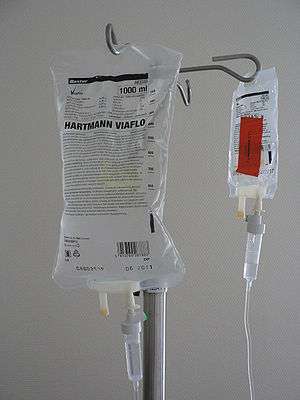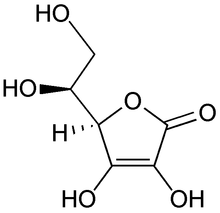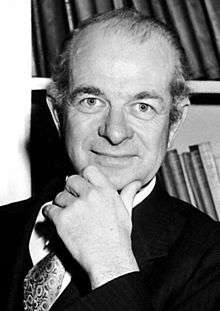Intravenous ascorbic acid
Intravenous Ascorbic Acid (also known as vitamin C or L-ascorbic acid), is a type of therapy that delivers soluble ascorbic acid directly into the bloodstream, either administered via injection or infusion. Intravenous ascorbic acid is used as a dietary supplement for nutritional deficiencies and also, as complementary therapy to cancer treatments. The use of intravenous ascorbic acid as a cancer treatment or co-treatment has been a controversial topic since the emergence of misleading data in the 1970s.[1] However, more recent research suggests an ability to decrease inflammation in the patient and to improve symptoms related to disease processes, and side effects of standard cancer treatments.[2][3][4][5][6][7]
| Intravenous ascorbic acid | |
|---|---|
 Intravenous bag and drip chamber on a pole, used to administer ascorbic acid solution through peripheral IV line | |
| Other names | Vitamin C, Ascorbate, L-ascorbic acid |
| ICD-10-PCS | Z51.81 |
| ICD-9-CM | 267 |
Medical uses
Nutritional deficiencies
In patients suffering from malnutrition or malabsorption, intravenous ascorbic acid can be used to treat deficiency. For people who are receiving all of their nutrient requirements via total parenteral nutrition there are vitamin products that include ascorbic acid.[8]
Contraindications
High doses of ascorbic acid administered by intravenous infusion have been shown to increase the absorption of iron.[9] However, in individuals with hemochromatosis (a genetic disorder where the body takes up and stores too much iron), intravenous ascorbic acid is contraindicated as high dosages of ascorbic acid may result in iron overloading and therefore, lead to life-threatening complications such as heart disease, diabetes, or tissue damage.[10]
High dosages of ascorbic acid (such as those used in intravenous therapy) have been reported to cause some intestinal discomfort, diarrhoea, as well as increased gas and urination.[7]
Pharmacology

Mechanism of action
Ascorbic acid operates as an anti-oxidant and essential enzyme cofactor in the human body. In in vitro studies, the primary mechanism of high dosage intravenous ascorbic acid can be related to ascorbic acid's pro-oxidant activity, whereby hydrogen peroxide is formed.[3][4][5] In the extracellular fluid of cells, ascorbic acid dissociates into an ascorbate radical upon the reduction of transition metal ions, such as ferric or cupric cations.[3] These transition metal ions will then reduce dissolved oxygen into a superoxide radical- this will then react with hydrogen to form hydrogen peroxide.[4]
Furthermore, according to Fenton chemistry, these transition metal ions can be further oxidised by hydrogen peroxide to generate a highly reactive hydroxyl radical.[6] The formation of hydrogen peroxide and hydroxyl radicals is believed to induce cytotoxicity and apoptosis of cancer cells.[6] Although many in vitro studies have studied hydrogen peroxide generation by ascorbic acid, the pharmacological mechanism of intravenous ascorbic acid in vivo is still unclear.[6]
History
Pioneering research
Although the pharmacology of ascorbic acid had been studied since its discovery in the 1930s,[11] the method of administration and its medicinal potential to human patients was not investigated until the 1940s.[12] In 1949, American physician, Frederick Klenner, published his scientific report, “The Treatment of Poliomyelitis and Other Virus Diseases with ascorbic acid”,[13] which detailed the use of intravenous ascorbic acid to treat polio in children.[12] Although Klenner's attempts were unsuccessful, his research pioneered future studies investigating the medicinal role of intravenous ascorbic acid. Klenner's work was recognised by Linus Pauling in the foreword to the Clinical Guide: "Dr. Fred Klenner's early research reports provide much information on the use of high-dose ascorbic acid for the prevention and cure of many diseases, and these reports are still important."[14]

Linus Pauling
Nobel Prize winner and biochemist, Linus Pauling, was pivotal in the re-emergence of intravenous ascorbic acid research. Over the course of the 1970s, Pauling would begin a long-term collaboration with fellow physician, Ewan Cameron, on the medical potential of intravenous ascorbate acid as cancer therapy in terminally ill patients. In 1976, Pauling and Cameron co-authored a study whereby a group of 100 terminal cancer patients underwent supplementary ascorbic acid therapy (10g/day by intravenous infusion and oral thereafter) and the control group of 1,000 patients did not.[15] Their findings reported that the survival rate of the terminal cancer patients increased by four-fold, compared to the control group, stating that: "the treatment of ascorbate in amounts of 10g/day or more is of real value in extending the life of patients with advanced cancer."[15]
Subsequent studies by Pauling and Cameron hypothesised that ascorbic acid's role in enhanced collagen production would lead to the encapsulation of tumours and thus, protect normal tissue from metastasis.[16] Following these findings, Pauling became a strong advocate for vitamin megadosing and continued to investigate the medicinal potential of intravenous ascorbic acid across a range of illnesses, including: HIV transmission, the common cold, atherosclerosis, and angina pectoris.[17][18][19]
Medical controversy
The efficacy of intravenous ascorbic acid therapy came under scrutiny of the medical and science community, following the numerous high-profile studies authored by Linus Pauling in the 1970s.[5] The experimental design of Pauling and Cameron's 1976 publication, "Supplemental ascorbate in the supportive treatment of cancer",[15] had garnered considerable criticism as it was neither randomised nor placebo controlled. To test the validity of Pauling and Cameron's findings, the Mayo Clinic conducted three independent experiments in 1979, 1983 and 1985, whereby terminal cancer patients were given doses of oral ascorbic acid under randomised, double bind and placebo-controlled conditions.[20][21][22] All studies concluded that high doses of oral ascorbic acid were not effective against cancer.
Recent research
In the 2000s, new research highlighted the important pharmacokinetic differences between intravenous infusions of ascorbic acid and oral supplementation; ultimately, these findings indicated that oral supplementation produces lower serum concentrations of ascorbic acid, as opposed to intravenous administration.[23]
Research directions
Cancer
The use of intravenous ascorbic acid in the treatment of cancer is a contentious issue. There is no evidence to indicate that intravenous ascorbic acid therapy can cure cancer.[24][22] However, reviews suggest therapeutic value to cancer patients undergoing treatment.[2][3][4][5][7][6][16] According to the U.S. Food and Drug Administration (FDA), high-dose vitamin C (such as intravenous ascorbic acid therapy) has not been approved as a treatment for cancer or any other medical condition.[25]
Cancer patients often have a compromised ascorbic acid status due to oxidative stress and chronic inflammation caused by the “metabolic state of the malignancy and its effects on host metabolism, the catabolic effects of antineoplastic therapy, and the physiologic stresses of disease processes”.[26] Therefore, high-dosages of ascorbic acid are administered intravenously to supplement these deficiencies.[1] The use of intravenous ascorbic acid in cancer patients has been shown to reduce inflammation, improve nutrient deficiencies and also, reduce post-oncological side effects related to chemotherapy or radiation therapy.[1]
As intravenous ascorbic acid therapy is currently used as a complementary treatment for cancer patients, there many been multiple studies devoted to investigating the medicinal properties of ascorbic acid. The use of high-dosage intravenous ascorbic acid as a cancer treatment was first promoted by Linus Pauling and Ewan Cameron in the 1970s;[15][16] however, these findings were later found to be unreliable by subsequent Mayo Clinic studies in the 1980s.[20][21][22] Nonetheless, the turn of the 21st century saw a renewed interest in the medical potential of intravenous ascorbic acid therapy. In the early 2010s, in vitro preclinical and clinical trials were undertaken to investigate the pharmacological mechanism of action of intravenous ascorbic acid therapy.[27][28] These findings demonstrated ascorbic acid's pro-oxidant capabilities to produce hydrogen peroxide and thus, proposed a possible pharmacological mechanism of action against cancer cells. Nonetheless, ascorbic acid's potential as an anti-tumour therapy is still dubious, as other pro-oxidant substances (such as menadione[29][30]) have been unsuccessful in the treatment of cancer patients.[31]
In 2010, an academic review which detailed 33 years of ascorbic acid and cancer research stated: "we still do not know whether Vitamin C has any clinically significant anti-tumor activity. Nor do we know which histological types of cancers, if any, are susceptible to this agent. Finally, we don't know what the recommended dose of Vitamin C is, if there is indeed such a dose, that can produce an anti-tumor response".[32]
COVID-19
As of April 2020, there are ten ongoing clinical trials of intravenous vitamin C for people who are hospitalized and severely ill with COVID-19; two placebo controlled (China, Canada) and one with no control (Italy).[33]
See also
References
- Nabzdyk CS, Bittner EA (October 2018). "Vitamin C in the critically ill - indications and controversies". World Journal of Critical Care Medicine. 7 (5): 52–61. doi:10.5492/wjccm.v7.i5.52. PMC 6201324. PMID 30370227.
- Klimant E, Wright H, Rubin D, Seely D, Markman M (April 2018). "Intravenous vitamin C in the supportive care of cancer patients: a review and rational approach". Current Oncology. 25 (2): 139–148. doi:10.3747/co.25.3790. PMC 5927785. PMID 29719430.
- Carr AC, Cook J (2018-08-23). "Intravenous Vitamin C for Cancer Therapy - Identifying the Current Gaps in Our Knowledge". Frontiers in Physiology. 9: 1182. doi:10.3389/fphys.2018.01182. PMC 6115501. PMID 30190680.
- Vissers MC, Das AB (2018-07-03). "Potential Mechanisms of Action for Vitamin C in Cancer: Reviewing the Evidence". Frontiers in Physiology. 9: 809. doi:10.3389/fphys.2018.00809. PMC 6037948. PMID 30018566.
- Verrax J, Calderon PB (December 2008). "The controversial place of vitamin C in cancer treatment". Biochemical Pharmacology. 76 (12): 1644–52. doi:10.1016/j.bcp.2008.09.024. PMID 18938145.
- Fritz H, Flower G, Weeks L, Cooley K, Callachan M, McGowan J, et al. (July 2014). "Intravenous Vitamin C and Cancer: A Systematic Review". Integrative Cancer Therapies. 13 (4): 280–300. doi:10.1177/1534735414534463. PMID 24867961.
- Ohno S, Ohno Y, Suzuki N, Soma G, Inoue M (March 2009). "High-dose vitamin C (ascorbic acid) therapy in the treatment of patients with advanced cancer". Anticancer Research. 29 (3): 809–15. PMID 19414313.
- "Cernevit™-12 (multivitamins for infusion)" (PDF). Food and Drug Administration. 1999.
- Jacob RA, Sotoudeh G (March 2002). "Vitamin C function and status in chronic disease". Nutrition in Clinical Care. 5 (2): 66–74. doi:10.1046/j.1523-5408.2002.00005.x. PMID 12134712.
- Institute of Medicine (US) Panel on Dietary Antioxidants Related Compounds (2000-04-11). Dietary Reference Intakes for Vitamin C, Vitamin E, Selenium, and Carotenoids. doi:10.17226/9810. ISBN 9780309069359. PMID 25077263.
- Carpenter KJ (2012). "The discovery of vitamin C". Annals of Nutrition & Metabolism. 61 (3): 259–64. doi:10.1159/000343121. PMID 23183299.
- "Intravenous Vitamin C: The Historical Progression". PaulingBlog. 2017-10-18. Retrieved 2019-05-20.
- "The Treatment of Poliomyelitis and Other Virus Diseases with Vitamin C". www.seanet.com. Retrieved 2019-05-20.
- "Clinical Guide to the Use of Vitamin C". www.seanet.com. Retrieved 2019-05-20.
- Cameron E, Pauling L (October 1976). "Supplemental ascorbate in the supportive treatment of cancer: Prolongation of survival times in terminal human cancer". Proceedings of the National Academy of Sciences of the United States of America. 73 (10): 3685–9. Bibcode:1976PNAS...73.3685C. doi:10.1073/pnas.73.10.3685. PMC 431183. PMID 1068480.
- Mikirova N, Casciari J, Riordan N, Hunninghake R (August 2013). "Clinical experience with intravenous administration of ascorbic acid: achievable levels in blood for different states of inflammation and disease in cancer patients". Journal of Translational Medicine. 11: 191. doi:10.1186/1479-5876-11-191. PMC 3751545. PMID 23947403.
- Pauling L (January 1973). "Ascorbic acid and the common cold". Scottish Medical Journal. 18 (1): 1–2. doi:10.1177/003693307301800101. PMID 4577802.
- Harakeh S, Jariwalla RJ, Pauling L (September 1990). "Suppression of human immunodeficiency virus replication by ascorbate in chronically and acutely infected cells". Proceedings of the National Academy of Sciences of the United States of America. 87 (18): 7245–9. Bibcode:1990PNAS...87.7245H. doi:10.1073/pnas.87.18.7245. PMC 54720. PMID 1698293.
- Rath M, Pauling L (August 1990). "Hypothesis: lipoprotein(a) is a surrogate for ascorbate". Proceedings of the National Academy of Sciences of the United States of America. 87 (16): 6204–7. Bibcode:1990PNAS...87.6204R. doi:10.1073/pnas.87.16.6204. PMC 54501. PMID 2143582.
- Creagan ET, Moertel CG, O'Fallon JR, Schutt AJ, O'Connell MJ, Rubin J, Frytak S (September 1979). "Failure of high-dose vitamin C (ascorbic acid) therapy to benefit patients with advanced cancer. A controlled trial". The New England Journal of Medicine. 301 (13): 687–90. doi:10.1056/NEJM197909273011303. PMID 384241.
- Tschetter L, Creagan E, O'Fallon J (1983). "A community-based study of vitamin C (ascorbic acid) in patients with advanced cancer". Proceedings of the American Society of Clinical Oncology. 2: 92.
- Moertel CG, Fleming TR, Creagan ET, Rubin J, O'Connell MJ, Ames MM (January 1985). "High-dose vitamin C versus placebo in the treatment of patients with advanced cancer who have had no prior chemotherapy. A randomized double-blind comparison". The New England Journal of Medicine. 312 (3): 137–41. doi:10.1056/NEJM198501173120301. PMID 3880867.
- Padayatty SJ, Sun H, Wang Y, Riordan HD, Hewitt SM, Katz A, et al. (April 2004). "Vitamin C pharmacokinetics: implications for oral and intravenous use". Annals of Internal Medicine. 140 (7): 533–7. doi:10.7326/0003-4819-140-7-200404060-00010. PMID 15068981.
- Klimant E, Wright H, Rubin D, Seely D, Markman M (April 2018). "Intravenous vitamin C in the supportive care of cancer patients: a review and rational approach". Current Oncology. 25 (2): 139–48. doi:10.3747/co.25.3790. PMC 5927785. PMID 29719430.
- "The Vitamin C Foundation - 514071 - 04/17/2017". U.S. Food and Drug Administration. 2019-04-23. Retrieved 2019-06-07.
- Hoffman FA (January 1985). "Micronutrient requirements of cancer patients". Cancer. 55 (1 Suppl): 295–300. doi:10.1002/1097-0142(19850101)55:1+<295::AID-CNCR2820551315>3.0.CO;2-X. PMID 3917362.
- Parrow NL, Leshin JA, Levine M (December 2013). "Parenteral ascorbate as a cancer therapeutic: a reassessment based on pharmacokinetics". Antioxidants & Redox Signaling. 19 (17): 2141–56. doi:10.1089/ars.2013.5372. PMC 3869468. PMID 23621620.
- Fritz H, Flower G, Weeks L, Cooley K, Callachan M, McGowan J, et al. (July 2014). "Intravenous Vitamin C and Cancer: A Systematic Review". Integrative Cancer Therapies. 13 (4): 280–300. doi:10.1177/1534735414534463. PMID 24867961.
- Tetef M, Margolin K, Ahn C, Akman S, Chow W, Leong L, et al. (1995). "Mitomycin C and menadione for the treatment of lung cancer: a phase II trial". Investigational New Drugs. 13 (2): 157–62. doi:10.1007/BF00872865. PMID 8617579.
- Margolin KA, Akman SA, Leong LA, Morgan RJ, Somlo G, Raschko JW, et al. (1995). "Phase I study of mitomycin C and menadione in advanced solid tumors". Cancer Chemotherapy and Pharmacology. 36 (4): 293–8. doi:10.1007/BF00689046. PMID 7628048.
- Borst P (December 2008). "Mega-dose vitamin C as therapy for human cancer?". Proceedings of the National Academy of Sciences of the United States of America. 105 (48): E95, author reply E96. Bibcode:2008PNAS..105E..95B. doi:10.1073/pnas.0809328105. PMC 2596258. PMID 19033231.
- Cabanillas F (September 2010). "Vitamin C and cancer: what can we conclude--1,609 patients and 33 years later?". Puerto Rico Health Sciences Journal. 29 (3): 215–7. PMID 20799507.
- "clinicaltrials.gov Vitamin C COVID-19". 26 March 2020. Retrieved 26 March 2020.